7) landforms of coastal deposition
1/33
There's no tags or description
Looks like no tags are added yet.
Name | Mastery | Learn | Test | Matching | Spaced |
|---|
No study sessions yet.
34 Terms
coastal deposition
occurs along the coast when waves no longer have enough energy to transport sediment
- beaches
- spits
- offshore bars
- tombolo
- sand dunes
- barrier beaches
- estuaries, mudflats and salt marshes
beaches
= a depositional landform extending from approximately the highest tide to the lowest tide
pebble vs sand
Sand beaches
= constructive waves, low energy, often sheltered form the wind and colonised by weather tolerant vegetation
- gentle gradient
- wide and sandy
- swash aligned beaches (affected by waves roughly parallel to the shore)
DEPOSITION
Pebble beaches
= destructive waves, high energy, exposed to the elements
- steep gradient
- often narrow with stones
- drift aligned beaches (longshore drift moves sediment along the beach)
EROSION
Summer and winter beach profiles
seasonal atmospheric condition may also contribute to beach profile
winter = low pressure and cyclonic conditions, high wind speeds and destructive waves
... steeper beach
summer = high pressure and anticyclonic conditions, lower wind speeds and constructive waves
... gentle gradient

action of waves on beach profiles
storm beaches = noticeable, semi-permanent ridges, larger, heavier sediment positioned by extreme weather conditions, found at level of the highest tide
berms = small scale beach ridges built up by successive levels of tides/storms
cusps = semi-circular scalloped embankments that are found in the shingle or at shingle sand junctions
cusps
1. due to the conflict of different wave directions and wave heights (due to refraction and reflection in a bay) there is a difference in distribution of wave energy
2. where the wave has reached a higher height, there is more power/energy so the wave can erode more of the bay
3. in the areas where the wave height has been decreased, the wave has less energy and doesn't erode as much
4. this is what forms cusps as the areas with high erosion become embankments and the areas with low erosion become horns
5. the cusp then self-organises itself so that the flow of water creates relief patterns by developing lower relief areas
6. these lowered relief areas attract and accelerate water particles so that they have more energy, and the relief is further eroded
7. through positive feedback, the relief becomes more and more eroded which creates an embayment
8. areas with higher relief (the horns) slow the water down and sediment is deposited on top of them, increasing their impact
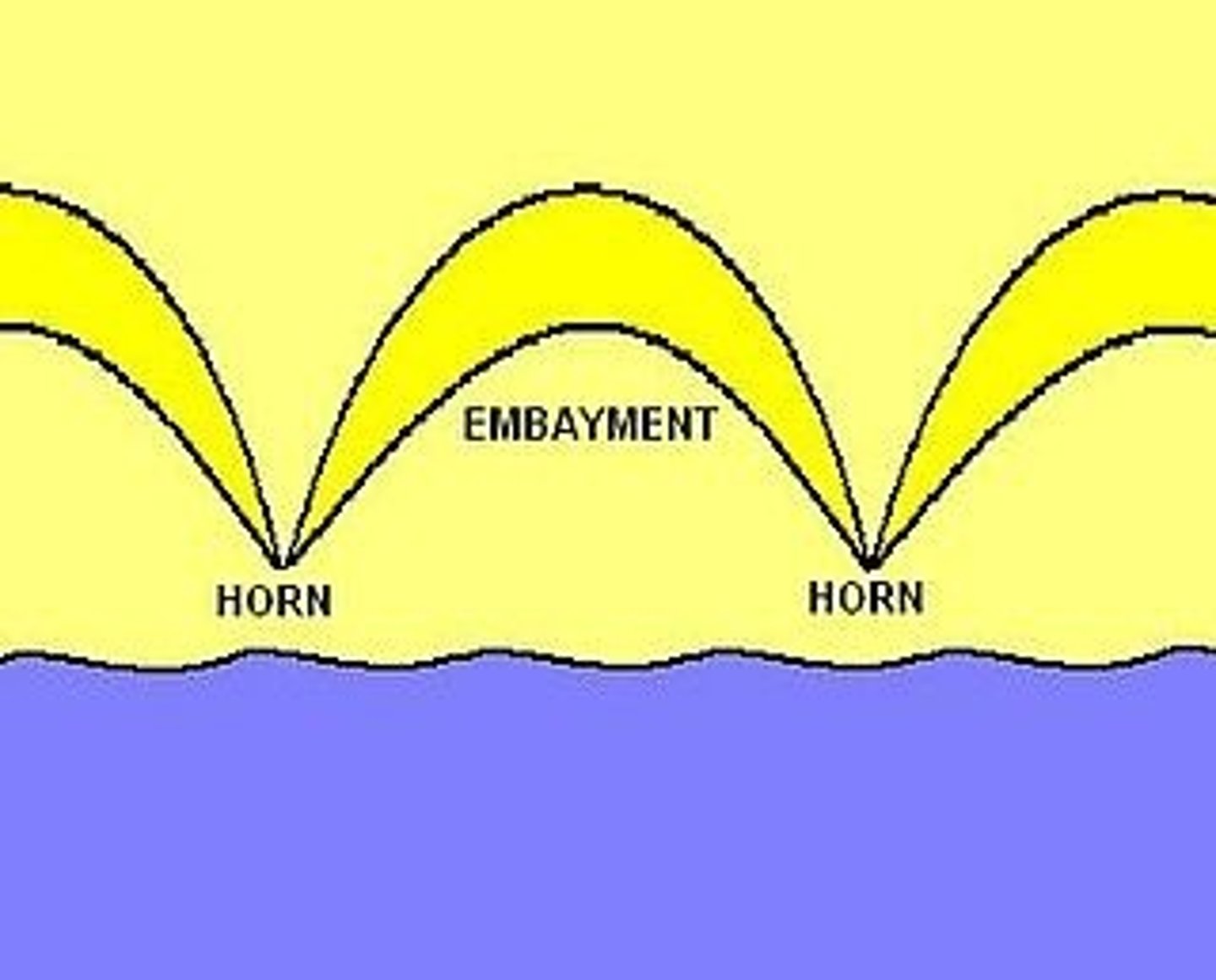
the equifinality of form
= where different processes can create the same landform
swash aligned beaches
- smoothly curving concave beaches
- beach face is orientated parallel to the front of the dominant waves
- sheltered beaches in bays, gets, etc
.
- sediment remains largely in place, only goes back and forth

drift aligned beaches
- oblique alignments to the dominant wave fronts
- usually occurs when beach has a steep gradient and wavelength is short
- exposed beaches
- crest breaks at different times along the beach
- littoral erosion, sediment gets moved away laterally

spits
= a long narrow feature made of sand or shingle that extends from the land into the sea (or part way across an estuary) forming on drift aligned beaches
1. sand/shingle is moved along the coast by LSD, but if the coastline suddenly changes direction...
....sediment begins to build up across estuary mouth
... forming a spit
2. the wind direction also changes which will prevent the spit from extending right across the new coastline as the end of the spit begins to curve round
... due to wave refraction and wind direction, material is deposited in a more sheltered area behind the spit ==> recurved tip
3. salt marsh may develop behind the spit where finer sediment settles and begins to be colonised by salt tolerant plants (sheltered area)
4. compound spits occur when transport processes are variable over time, producing a series of "barbs" along the spit
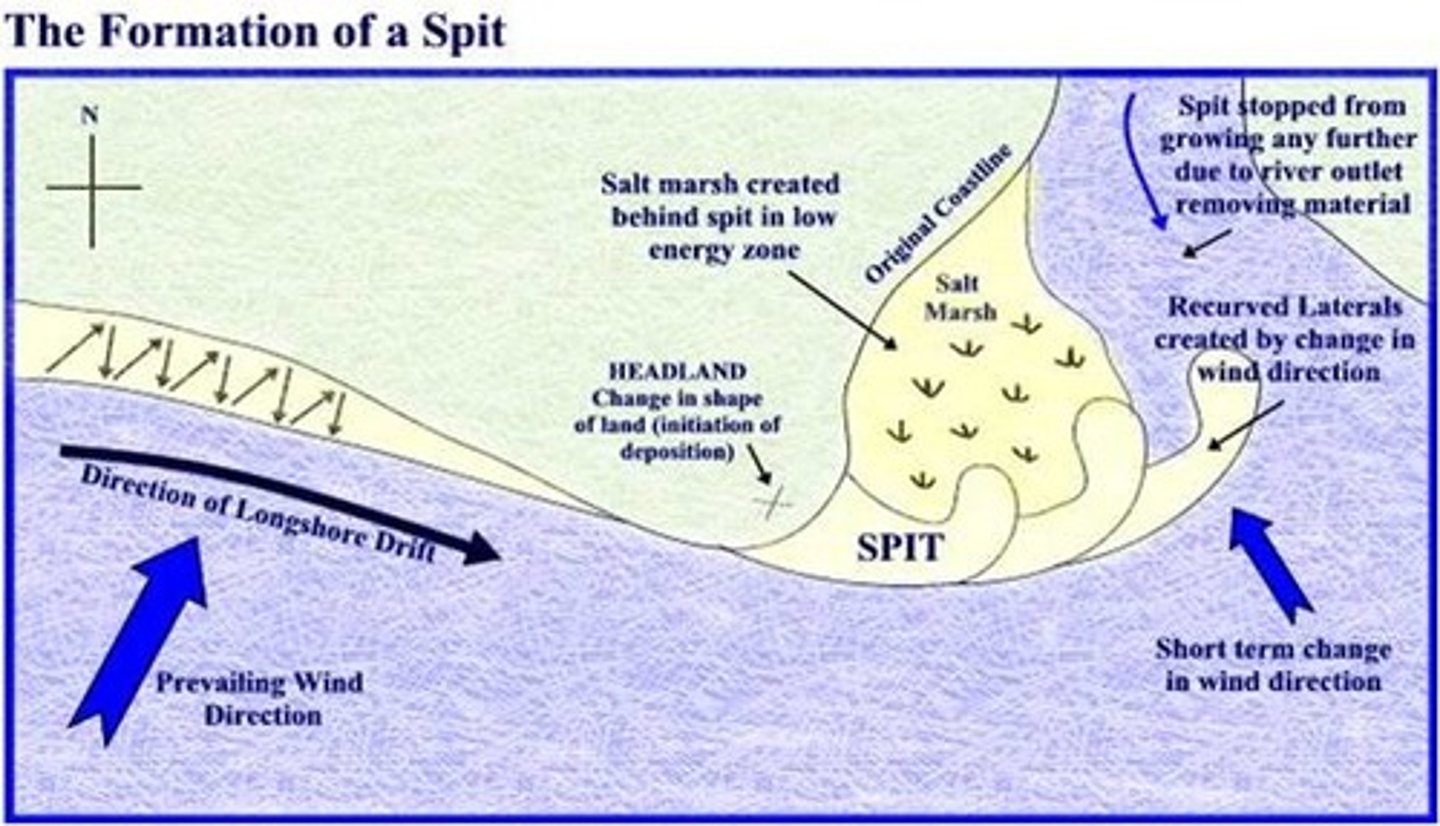
tombolo
= a beach/ridge of sand and shingle that has formed between a small island and the mainland
... deposition occurs where waves lose energy and the tombolo moves up
may be covered at high tide
e.g.,
St Nina's isle to Mainland, sheltland Uk
e.g.,
shodo island, Japan
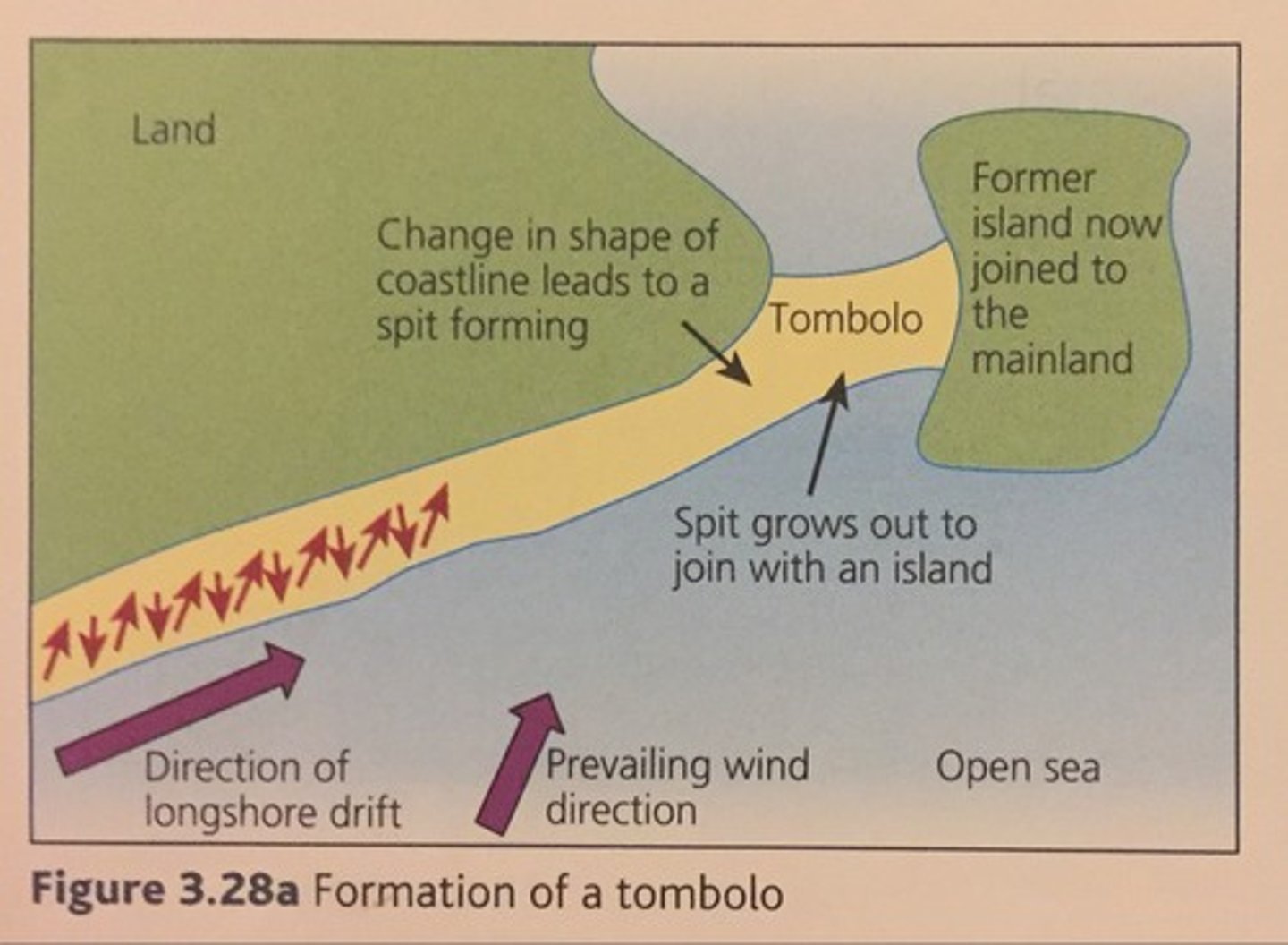
offshore bars
= submerged/partly exposed ridges of sand or coarse sediment created by waves offshore from coast
1. destructive waves erode the sand from a beach with strong backwash and deposit it offshore
2. offshore bars act as sediment sinks and potential sediment input stores
3. can absorb wave energy and reduce the impact of waves on a coastline
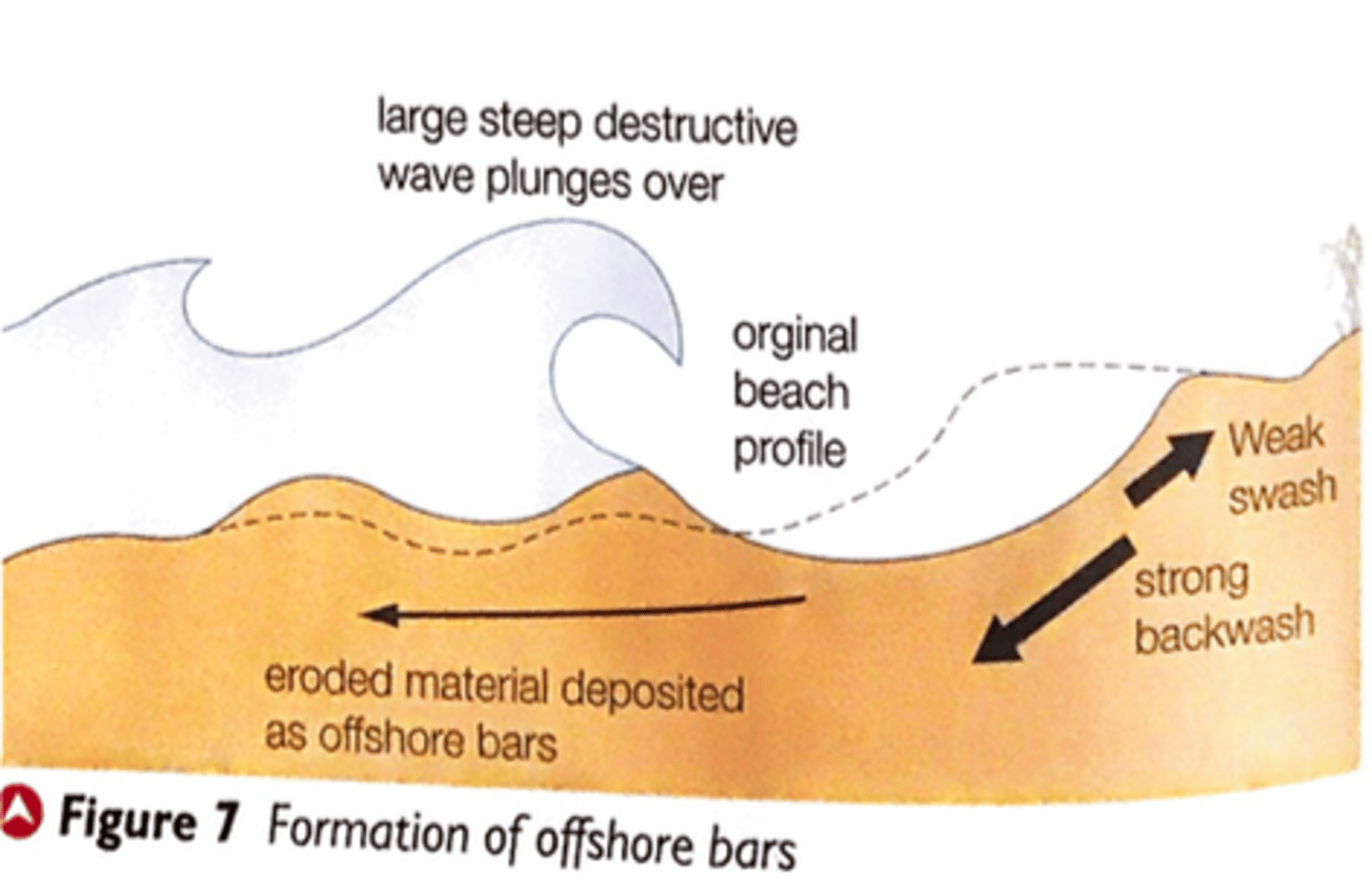
barrier islands
= coastal islands which are parallel to the mainland shore
- pleistocene sediments left over from ice age are washed towards the mainland or longshore drift transports it, forming a split
e.g., outer banks, North Carolina

lagoons
= lanyard side of a barrier island so it is protected from large waves
... low energy environment, fine mud deposits form tidal flats

cuspate foreland
2 dominant wind directions fuelling longshore drift collide together so that all the sediment is piled up into one area, gradually building it up
= can be shaped by waves into a horn shape
e.g.,
Dungeness, Kent
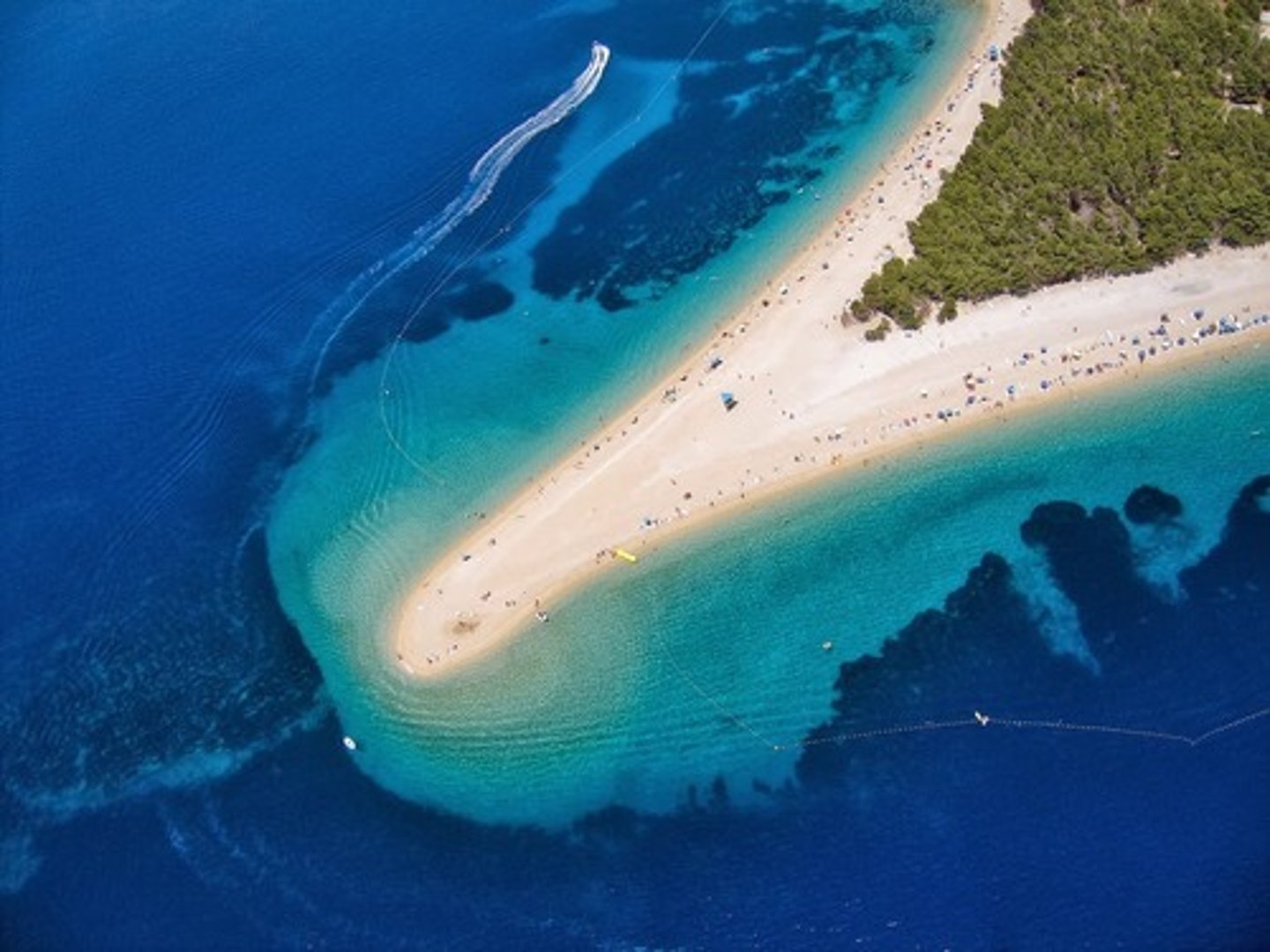
process sequences
= landform stages (cave, arch, stack, stump)
casual sequences
= explanations of features
e.g., cliff erosion
... beach deposition, hydraulic action, wave cut notch, cliff erosion
spatial sequences
= consequences of the location + tectonics
e.g.,
fjords
temporal sequence
= consequences of processes over time
e.g.,
sea level rise
sand dune ecosystems
= psammoseres
- form in depositional coastal environments where longshore drift dominates, accumulating large amounts of sand over time
- the wind blows the sand into the dunes and specialist plants colonise the dunes
particular species of plant is determined by climate
e.g.,
temperate zones = marram grass, adapted to hostile marine environments
for sand dunes to form...
- low energy coastal environments
- large quantities of sand must be available, washed onshore by constructive waves
- large tidal ranges, creating a large exposure of sand that can dry out at low tide and be transported by the wind
- dominant onshore winds that blow the dried out sand as the dunes gradually develop (over a time = vegetation succession)
vegetation succession
==> dune develop where sand is initially trapped by debris towards the back of the beach where vegetation colonises the dunes and helps to stabilise the sand as dunes gradually develop
(over time = vegetation succession)
first colonising plants = pioneer species, have special adaptations to help them survive in hostile conditions
pioneer plants help bind sand and form low sand dunes (fore dunes)
marram grass is extremely well adapted with long roots to obtain water - growth is stimulated by burial and tangle of roots which bind the sand
as the environment changes over time, different species collies sand dunes until he final community is adjusted to the climatic conditions if the area
= the climatic climax community
wind transportation processes
saltation
creep
suspension
saltation
= middle sized particles are light enough to be bounced across the surface by the wind
... most dominant form of transportation
creep
= heavier paretic;es are rolled across the surface, accumulating more particles as they move
suspension
= the lightest particles are lifted by the wind and suspended in the air
... travel the furthest
stages of sand dune succession
embryo dune, foredune, second large dune, dune pasture, carr woodland
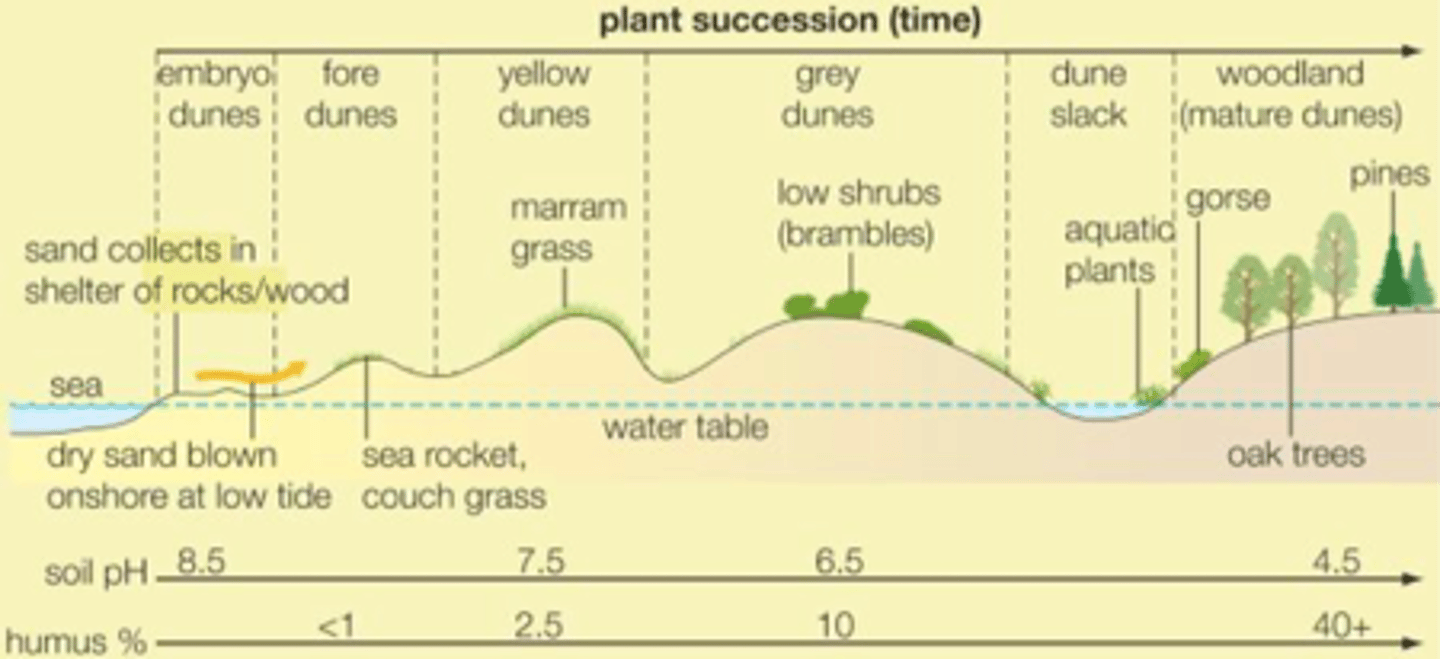
formation of a sand dune 4 marker
Constructive waves wash the particles onshore where they are able to dry out because of large tidal ranges exposing areas of sand.
Longshore drift and onshore winds then transport the particles via the processes of saltation, creep, and suspension.
The dunes initially develop where trapped debris at the back of beach accumulates and slow down the velocity of the wind, allowing it to deposit the particles.
Colonising pioneer species have special adaptations which allow them to survive in hostile environments and stabilise the sand dunes as they develop, such as marram grass, which has shallow roots which help with the uptake of water.
More species colonise the sand dunes until it reaches the climatic climax community when the environmental conditions are stable.
The vegetation, such as marram grass, also act as barriers which slow the velocity of the wind down further, allowing it to grow bigger as the wind deposits more particles.
The vegetation may evolve as the environment no longer becomes hostile on the initial dunes and plants compete against other plant species.
Carr woodlands
at the back of the beach there are less hostile environments, more plants can grow here as less adaptations are needed
woodland develops
Marram grass adaptations
- leaves can roll up to reduce the exposure of the wind, resulting in less water vapour loss through stomata via gas exchange
- thick waxy cuticles to reflect sunlight, water doesn't evaporate out of lead + leaf is waterproofed
- fewer stomata to reduce the loss of water
- shallow roots to absorb as much water as possible
sea rocket adaptations
- able to cope with dry, salty, exposed conditions
- add organic matter back into developing soil when they die
- long roots to help stabilise it
- waxy cuticle to help retain moisture
embryo dunes to dune slacks
embryo dunes first to develop, then grow bigger into fore dunes (initially yellow in colour and then darken to grey as decaying plants add humus)
depression between dunes can develop into dune slacks - damper areas where the water table is closer to/at the surface
fragile ecosystems (sand dunes)
can be easily destroyed by excessive trampling or overgrazing by livestock
- areas of sand dunes have excellent beaches, creates tourist pressures
- nearly all sand dune ecosystems are SSSI's (sites of special scientific interest)